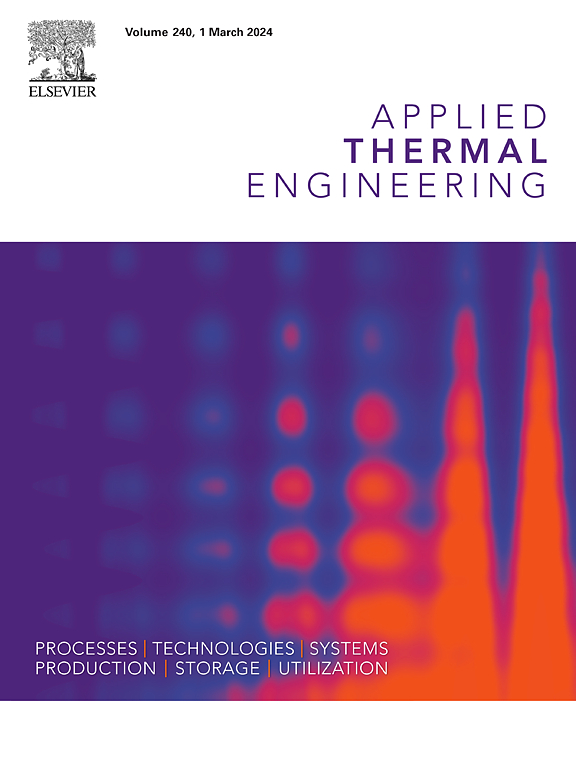Novel solid oxide electrolysis cell system thermally integrated with the Haber–Bosch process
IF 6.1
2区 工程技术
Q2 ENERGY & FUELS
引用次数: 0
Abstract
A solid oxide electrolysis cell (SOEC) system thermally integrated with Haber-Bosch (HB) process is a potential solution for improving the hydrogen and ammonia economies in terms of production, storage, and transportation. By utilizing waste heat from the HB process to generate steam for the SOEC system, overall system efficiency for green ammonia production can be improved. In this study, numerical model of the SOEC–HB hybrid system is developed using Aspen Plus®. The SOEC model is validated by comparing the current density–voltage polarization curves obtained for various stack temperatures and hydrogen inlet mole fractions with the experimental data. To confirm the superiority of proposed SOEC–HB hybrid system, its efficiency is compared to that of the arithmetic summation of the SOEC and HB systems without thermal integration. To optimize the operating conditions for the proposed hybrid system, parametric analysis is conducted by varying the operating parameters, including the SOEC stack operating temperature, current density, steam utilization, stack outlet hydrogen mole fraction, HB reactor (HBR) outlet temperature, and hydrogen-to-nitrogen ratio (HTNR). Compared to the SOEC-HB system without thermal integration, the overall efficiency of SOEC–HB hybrid system increases by 3.33 % under nominal conditions of operating temperature of SOEC stack of 700 °C, a current density of 1.0 A/cm2, a steam utilization of 50 %, hydrogen mole fraction of 20 mol.%, an outlet temperature of HBR of 427 °C and a HTNR of 3.0. This improvement is attributed to the reduction in heat consumption by the vaporizer.
新型固体氧化物电解电池系统与Haber-Bosch工艺热集成
固体氧化物电解池(SOEC)系统与Haber-Bosch (HB)工艺热集成是一种潜在的解决方案,可以在生产、储存和运输方面提高氢和氨的经济性。通过利用HB过程的余热为SOEC系统产生蒸汽,可以提高绿色氨生产的整体系统效率。在本研究中,利用Aspen Plus®开发了SOEC-HB混合动力系统的数值模型。通过将不同堆温和氢气入口摩尔分数下的电流密度-电压极化曲线与实验数据进行对比,验证了SOEC模型的正确性。为了验证所提出的SOEC - HB混合系统的优越性,将其效率与没有热集成的SOEC和HB系统的算法求和进行了比较。为了优化所提出的混合系统的运行条件,通过改变SOEC堆工作温度、电流密度、蒸汽利用率、堆出口氢摩尔分数、HB反应器(HBR)出口温度和氢氮比(HTNR)等运行参数进行参数分析。在SOEC堆工作温度为700℃、电流密度为1.0 a /cm2、蒸汽利用率为50%、氢摩尔分数为20 mol.%、HBR出口温度为427℃、HTNR为3.0的条件下,与无热集成的SOEC- hb系统相比,SOEC- hb混合系统的总效率提高了3.33%。这一改进是由于蒸发器的热量消耗减少。
本文章由计算机程序翻译,如有差异,请以英文原文为准。
求助全文
约1分钟内获得全文
求助全文
来源期刊

Applied Thermal Engineering
工程技术-工程:机械
CiteScore
11.30
自引率
15.60%
发文量
1474
审稿时长
57 days
期刊介绍:
Applied Thermal Engineering disseminates novel research related to the design, development and demonstration of components, devices, equipment, technologies and systems involving thermal processes for the production, storage, utilization and conservation of energy, with a focus on engineering application.
The journal publishes high-quality and high-impact Original Research Articles, Review Articles, Short Communications and Letters to the Editor on cutting-edge innovations in research, and recent advances or issues of interest to the thermal engineering community.
 求助内容:
求助内容: 应助结果提醒方式:
应助结果提醒方式:


